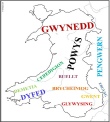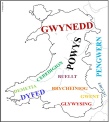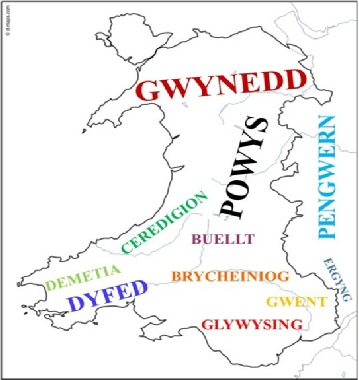383-420 End of Roman Era in Cymru
Cymru was under the control of Macsen Wledig’s sons for a brief period after the departure of the Roman army in 383, but they were soon overwhelmed by the Irish of Niall Noígíallach (Niall of the Nine Hostages). The Votadini of Manaw Gododdin, led by Cunedda, then arrived to secure the north and formed the kingdoms of Gwynedd and Ceredigion. The Irish had also settled in the west of the country, and founded the kingdoms of Demetia (later Dyfed) and Brycheiniog.

After the fall of the Roman Empire, Christianity gradually became the religion of the Cymry (Welsh people). This period was known as the Age of the Saints, with many religious settlements being founded by leaders such as Dyfrig, Cadwg, Illtud, Dewi, Cadfan and Deiniol. Many of these settlements - or llans - developed into villages, towns and cities of modern-day Cymru, whose names are often prefixed by the word llan.
c.425 Gwrtheyrn (Vortigern)
Gwrtheyrn controlled Prydain as a military leader from around 425 and invited Anglo Saxon mercenaries to join him in defending it from attacks by the Picts and the Scots. Power in the east of Prydain gradually passed to the pagan Anglo Saxons, however, and the rulers of Cymru spent much of this period defending their lands against them, especially in the border lands of Powys, Gwent and Gwynedd.
c.430 Battle of Maes Garmon
The Prydeinwyr (Britons), led by Garmon (Germanus), defeated an alliance of Picts and Scots in battle, and he then defeated and killed Gwrtheyrn near the river Teifi about 30 years later. This was a particularly violent and unstable period in the history of Cymru, where its rulers were under the constant threat of invasion from Anglo-Saxons, Scots or Irish and Picts.
c.480- c.537 ‘Arthur’s Battles
A number of battles took place at the end of the 5th century and the beginning of the 6th - and in many of these ‘Arthur’ is named as the leader of the Prydeinwyr. Legends, such as those involving the ‘Twrch Trwyth’, are based on these battles, and some historians have suggested that ‘Arthur’ was Owain Ddantgwyn, the king of Rhos and a grandson of Cunedda.
577 Battle of Deorham
In 577, land contact between Cymru and the kingdoms of Devon and Cornwall was severed following the battle of Deorham near Bath, and its links with Yr Hen Ogledd (The Old North) were also weakened following the battle of Catraeth (Catterick) in 598.
c.600 Battle of Rhyd Tyndyrn
A decisive battle took place at Tyndyrn (Tintern) where an army led by Tewdrig repelled an attack by a large Anglo-Saxon force. This established control in the area by the Cymry.
616 Battles of Chester and Bangor Iscoed
Land contact between Cymru and Yr Hen Ogledd was probably severed in battles at Chester and Bangor Iscoed, where a number of the leaders of Gwynedd, Powys and Pengwern were killed by an army led by Aethelfrith, the king of Bernicia.
625 Cadwallon ap Cadfan
Following the death of Cadfan ap Iago, his son, Cadwallon ap Cadfan, became king of Gwynedd, and he would eventually lead the Cymry in defence against Anglo Saxon attacks.
After losing a good deal of land to Anglo-Saxon kingdoms during the 6th and early 7th centuries, the Cymry were continually fighting to defend what they had left. The Mercians built Wat’s Dyke and then Offa’s Dyke to keep hold of these newly-acquired lands.



